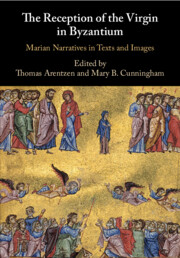
-
Select format
-
- Publisher:
- Cambridge University Press
- Publication date:
- August 2019
- August 2019
- ISBN:
- 9781108696791
- 9781108476287
- 9781108700139
- Dimensions:
- (247 x 174 mm)
- Weight & Pages:
- 0.93kg, 378 Pages
- Dimensions:
- (244 x 170 mm)
- Weight & Pages:
- 0.73kg, 388 Pages
- Subjects:
- Religion, Church History
Book description
This book explores how the Virgin Mary's life is told in hymns, sermons, icons, art, and other media in the Byzantine Empire before AD 1204. A group of international specialists examines material and textual evidence from both Byzantine and Muslim-ruled territories that was intended for a variety of settings and audiences and seeks to explain why Byzantine artisans and writers chose to tell stories about Mary, the Mother of God, in such different ways. Sometimes the variation reflected the theological or narrative purposes of story-tellers; sometimes it expressed their personal spiritual preoccupations. Above all, the variety of aspects that this holy figure assumed in Byzantium reveals her paradoxical theological position as meeting-place and mediator between the divine and created realms. Narrative, whether 'historical', theological, or purely literary, thus played a fundamental role in the development of the Marian cult from Late Antiquity onward.
Contents
Metrics
Altmetric attention score
Full text views
Full text views help Loading metrics...
Loading metrics...
* Views captured on Cambridge Core between #date#. This data will be updated every 24 hours.
Usage data cannot currently be displayed.
Accessibility standard: Unknown
Why this information is here
This section outlines the accessibility features of this content - including support for screen readers, full keyboard navigation and high-contrast display options. This may not be relevant for you.
Accessibility Information
Accessibility compliance for the PDF of this book is currently unknown and may be updated in the future.


